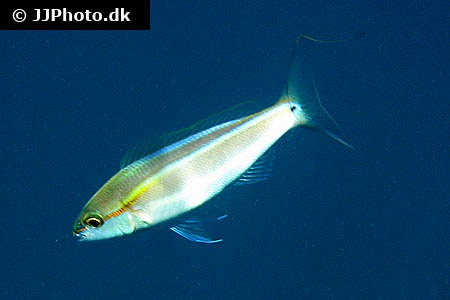Pentapodus setosus

| Latin name | Pentapodus setosus - (Valenciennes, 1830) |
|---|---|
| Local name | Butterfly whiptail |
| Family | Nemipteridae - Pentapodus |
| Origin | The Mexican Golf |
| Max length | 18 cm (7.1") |
| Minimum volume |
600 l (158 gal) |
|---|---|
| Hardiness |
Average |
| Suitable for aquarium |
Suitable with care |
| Reef safe |
Reef safe with caution |
| Aggressiveness | Mostly peaceful but might be aggressive towards similar species |
| Recommended |
Fish Larger crustaceans (Shrimp, crabs...) Other invertebrates Small crustaceans (Krill, mysis, artemia...) Zooplankton (Cyclops, pods...) |
|---|
This species is known to jump out of open aquaria.
This spicies might be a threat to smaller fishes.
This species poses a threat towards shrimps and crabs etc., which are relatively small.
This species searches through the sand for food, which can make the water cloudy and shakes up detritus.
In an aquarium their natural food source in the sand is quickly exhausted.
This species must be fed with an appropriately varied diet.
These fish flourish better without other members of the same species in the aquarium.
There is a greater chance of success with this species if one can supply a living feed to allow it to adapt to the tank.
This fish requires feeding several times a day, especially when newly added.
When the fish can find its natural food in the aquarium it requires less frequent feeding.
This species needs good hiding places, for example, between live rocks.
This species revels in swimming and requires an aquarium with ample space.
This species can be very shy when first introduced into a new aquarium.
More aggressive fish can be introduced after this species has acclimatized.
The Threadfin Bream (Nemipteridae) is an often overlooked fish by aquarists, they are both attractive and interesting to keep in an aquarium, as long as one can provide them with an appropriate environment.
The substrate colour can influence their appearance. They are by far the most attractive with a dark substrate.
These fish like to eat food from the bottom and until they get used to eating in the water column, it is vital to be certain they obtain enough food from the start.
As they grow larger, they can become a threat to small crustaceans and small fish.
| Aquarium trade | No |
|---|---|
| Distribution | Western Central Pacific: Philippines, South China Sea, Singapore, and Indonesia. |
| English common names |
Butterfly whiptail |
Scott W. Michael. 2004. Angelfishes and Butterflyfishes (Reef Fishes Series Book 3) TFH Publications / Microcosm Ltd. - (English)
Bob Fenner. They Could be Pet-Fish, Threadfin or Sea Breams Family Nemipteridae - Wet Web Media - (English)
Bob Fenner. FAQs on the Threadfin or Sea Breams, Family Nemipteridae - Wet Web Media - (English)

